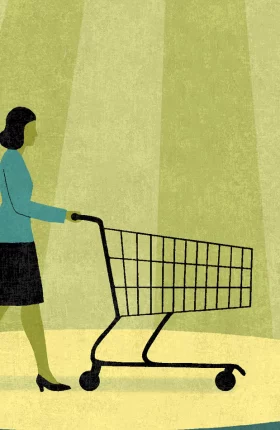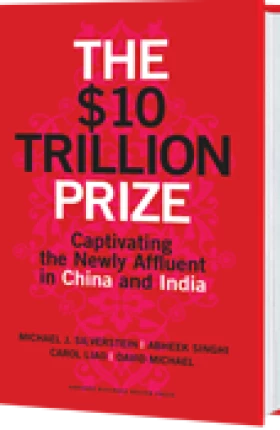For roughly three decades, China’s booming economy has offered consumer product companies some of the world’s greatest growth opportunities. China’s economic slowdown and jittery markets have raised worries that this growth story is drawing to a close. In early November 2015, for example, the government lowered its official five-year annual GDP growth target to 6.5%, the slowest pace since the 2008–2009 global financial crisis.
China’s economy is indeed struggling through a significant structural transition, and consumption isn’t rising as fast as it did during the peak boom years. But make no mistake: although the pace is slower and the course is bumpier, consumption growth is still tracing a staggering trajectory. China’s consumer economy is projected to expand by about half, to $6.5 trillion, by 2020—even if annual real GDP growth cools to 5.5%, below the official target. The incremental growth of $2.3 trillion alone over the next five years would be comparable to adding a consumer market 1.3 times larger than that of today’s Germany or UK. (See Exhibit 1.)
The Chinese consumer market, moreover, is in the midst of a transformation that offers tremendous new opportunities. Three great forces are ushering in this transformation: the rise of upper-middle-class and affluent households as the drivers of consumption growth; a new generation of freer-spending, sophisticated consumers; and the increasingly powerful role of e-commerce.
Research by The Boston Consulting Group and AliResearch, the research arm of Alibaba, China’s largest e-commerce company, found that these three forces of change will profoundly reshape China’s economy and consumer market over the next five years. Through 2020, 81% of consumption growth will come from households whose annual income is more than $24,000. Furthermore, consumers 35 or younger will account for 65% of growth. E-commerce will become a far more important retail channel, driving 42% of total consumption growth, 90% of that growth coming from mobile e-commerce.
The types of products fueling China’s consumer boom will also change. Services will overtake goods as the chief engine, accounting for 51% of incremental growth over the next five years. Demand for premium goods and services that enhance a personal sense of well-being—such as healthy foods, education, and travel, rather than daily necessities—will accelerate.
Companies will need a new playbook to capture the coming wave of growth. The strategies of the past will no longer be relevant.
Consumption Will Continue to Surge
There are several reasons to be bullish on Chinese consumption, which we project will grow 9% annually through 2020. One is that incomes are rising. Per capita income in China has been increasing at an 11% annual pace since 2010. With China’s job market tight, average wages should continue to rise over the near term as the economy shifts from low-wage manufacturing industries to better-paying service and high-tech industries.
Rising incomes—and optimism that incomes will continue to rise—have kept consumer sentiment at its highest levels since 2008–2009. (See “ A Tale of Two Chinese Consumers ,” BCG article, June 2015.) There has been widespread concern that recent declines in China’s stock market will dampen consumer spending. We believe such worries are exaggerated. After all, only 15% of urban households have stock investments. Furthermore, according to a survey of 2,000 Chinese consumers that BCG’s Center for Customer Insight conducted after the stock market crash, macroeconomic trends have thus far had minimal influence on consumer sentiment. Only 7% of Chinese consumers responded that stock market trends would influence their decision to spend more or less. Just 8% also cited housing-market trends. Respondents indicated that other factors would be more influential: 35% cited rising incomes, for example.
Another reason for bullishness is that average consumers are spending more, and demographic trends and the expansion of e-commerce indicate that they will continue to spend more.
The Three Forces of Change
To understand the implications of the three forces that are changing China’s consumer economy, BCG and AliResearch analyzed the relationships of demographic, social, and technological trends and consumption.
One key finding: a two-speed consumer economy is emerging in China. (See Exhibit 2.) High-speed growth is occurring in upper-income brackets, among the younger generation, and in e-commerce channels, but consumption growth is decelerating among lower-income and older-generation consumers and in traditional retail channels.
The Rise of the Upper-Middle Class. During the past few decades, China’s consumer economy has been powered by the ascent of hundreds of millions of people from poverty to an emerging-middle class, which includes households with annual disposable income of $10,001 to $16,000, and to the middle class, those with incomes of $16,001 to $24,000.
China is entering a new era. Consumption growth will be driven by the dramatic rise of upper-middle-class households ($24,001 to $46,000 in annual disposable income) and affluent households (more than $46,000). We project that by 2020, the number of upper-middle-class and affluent households will double to 100 million and account for 30% of all urban households, compared with 17% today and only 7% in 2010. Furthermore, upper-middle-class and affluent households will account for 55% of Chinese urban consumption and 81% of its incremental growth over the next five years.
Consumption among upper-middle-class and affluent households is growing at 17% per year and, by 2020, will account for $1.5 trillion in incremental spending in urban China. That compares with a 5% growth rate among emerging-middle-class and middle-class consumers. Even though their share of urban consumption will drop from today’s 48% to 39% in 2020, such households will continue to make up a market that is too enormous to ignore. Because more of today’s low-income households will enter the lower rungs of the middle class over the next five years, these segments will still account for roughly half of urban households. The emerging-middle class and middle class will remain the biggest consumers in many categories, particularly such fast-moving consumer goods as personal-care products and detergents.
Companies will have to venture far beyond China’s biggest metropolitan areas to win the loyalty of upper-middle-class and affluent households. There are high concentrations of such households in more than 2,000 Chinese cities. We estimate that to reach 80% of this market in 2020, companies will need to establish their presence in 430 cities.
We project that the number of upper-middle-class and affluent households in tier 1 cities—huge metropolises such as Beijing, Shanghai, and Guangzhou—will increase by 10% per year through 2020, reaching 30 million. But the fastest growth will be in small cities. Of the 46 million additional upper-middle-class and affluent households that will emerge in China by 2020, half will likely be located outside the top 100 cities. We classify these cities as tier 4 or lower.
The Emergence of a New Generation. People born in the 1980s, 1990s, and the first decade of this century—a segment known in China as the “young generation” as opposed to the “last generation,” consumers who were born in the 1950s, 1960s, and 1970s—are poised to become the dominant force in the consumer market. Consumption by young-generation Chinese consumers is growing at a 14% annual rate—twice the pace of consumers older than 35. The share of total consumption by the young generation is projected to increase from 45% to 53% by 2020.
Young-generation Chinese spend more than their elders. Most Chinese older than 35 have lived through periods of instability and have experienced challenging economic circumstances. They are known to be frugal. The young generation is more motivated to spend. Our data shows that upper-middle-class consumers 35 and younger average 40% higher spending, across a range of product categories, than last-generation consumers with similar incomes. In a recent BCG global consumer survey, 42% of Chinese aged 18 to 25 disagreed with the statement, “I feel I have enough things and feel less the need to buy new ones.” By comparison, 36% of U.S. and EU respondents of that age-group, 32% of Japanese, and only 26% of Brazilians also disagreed with the statement.
Young-generation Chinese also tend to be more sophisticated consumers than those older than 35. They are eight times more likely to be college graduates. They travel overseas twice as much. And they are more brand conscious than older Chinese and U.S. consumers of the same age.
The Growing Role of E-Commerce. One of the most revolutionary changes in the Chinese consumer economy has been the astounding growth of e-commerce. In 2010, online transactions made up only 3% of total private consumption. The number of Chinese online shoppers has since nearly tripled, to 410 million, as has the amount that the average consumer spends online. Online channels now account for 15% of private consumption.
Over the next five years, e-commerce could become an even more important retail channel in China. Private online consumption is projected to surge by 20% annually through 2020, compared with 6% annual growth in off-line retail sales. This means that e-commerce will account for 42% of growth in private consumption. By then, China’s online consumer market will have grown to $1.6 trillion annually—24% of private consumption. (See Exhibit 3.)
Mobile e-commerce, which already accounts for 51% of all online sales in China, compared with a global average of 35%, will grow even faster. On Taobao, a Chinese e-commerce marketplace founded by Alibaba, the share of sales transacted though mobile devices rather than PCs rose from 51% to 62% within the first three quarters of 2015 and reached 68% on the year’s Singles Day (November 11, 2015), one of China’s biggest shopping days because retailers offer special promotions. By 2020, mobile e-commerce is projected to account for 74% of all online sales in China.
In addition to offering better prices and wider selections, e-commerce actually stimulates new demand in China by filling many needs that aren’t being met at brick-and-mortar stores. For example, according to Taobao, spending by the average e-shopper on organic and imported food and beverages has expanded eightfold over the past three years. Many popular online offerings, such as organic baby foods, rice, and tea, aren’t carried in local stores.
Chinese consumers also buy higher-priced products online. Our research found that overall consumption of home care products, packaged foods, and personal-care items increases only moderately as Chinese households become more affluent. But according to Taobao sample data, online purchases in these categories increase by around 150% when Chinese households enter the upper-middle class. Online purchases nearly double again among affluent households. In large part, that’s because these consumers can find more distinctive, premium-priced products online.
E-commerce drives consumption growth by helping companies overcome distribution challenges associated with reaching a national market and by dramatically expanding the reach of their brands. We analyzed Taobao sales of several leading premium skin-care brands that already have fairly wide coverage in department stores. We found that only 55% of Taobao’s online sales originated in cities that have those goods physically available in stores; 45% of sales were from the thousands of cities that don’t have those goods in stores. The trend was similar for fashion apparel and baby education products.
The Impact on China’s Consumer Market
The three forces of change will profoundly alter the landscape of China’s consumer market. The growing role of richer, younger, Internet-savvy consumers will boost demand for different kinds of products purchased through different kinds of retail channels. Indeed, this emerging consumer class will transform the structure of China’s economy.
Services will become the main economic engine. Powered by the growth of the upper-middle class, spending on services in China is projected to increase 11% annually through 2020, accounting for 51% of all growth in urban consumption. Spending on physical goods, by contrast, is projected to grow by 8% per year.
One reason is that wealthier consumers spend a disproportionately greater share of their incomes on services than do lower-income consumers. Although the average income of upper-middle-class and affluent households is 2.5 times higher than that of emerging-middle- and middle-class households, the wealthier spend 3.3 times more on education, culture, and entertainment. Still, upper-middle-class and affluent households spend only 1.8 times more on physical goods than emerging-middle and middle-class consumers.
The rapid development of digital channels will further enable the growth of services. Only six months after launching its lifestyle-service channel last year, Taobao had customers in 300 cities. Most were 35 or younger and were making online arrangements for home-based services. Each day, for example, 2,600 house cleaners were booked.
Value growth will replace volume growth in many categories. The huge expansion of China’s emerging-middle class over the past decades has fueled rapid revenue growth in many categories, especially fast-moving consumer goods. Volume growth in such product categories is now slowing as the market approaches saturation. Approximately 70% of such households now consume ready-to-drink tea preparations, for example, compared with fewer than 40% in 2007. Spending for many higher-value products, however, is ready to accelerate as a result of the growth of the upper-middle class. According to our analysis, as consumers enter this income segment, their consumption of luxury goods, wine, automobiles, and overseas travel increases sharply.
Consumers will engage more with brands. Young Chinese consumers are among the world’s most brand conscious. On average, the Chinese consumers aged 18 to 35 we surveyed were aware of 20 skin-care brands, for example. U.S. consumers in the same age range were aware of 14. Also, 49% of young-generation Chinese said that they advocate for brands, either personally or online, compared with 34% of U.S. consumers of similar age. Young Chinese also have a greater emotional connection with brands. A top priority of 18- to 25-year-old Chinese consumers buying skin care products is that the brands should “fit their personality” and convey that they are “young and energetic.”
In another sign of their growing sophistication, young Chinese are increasingly open to local brands. In our experience, first-time buyers of certain goods in emerging markets trust well-known international brands more than domestic ones. As consumers gain experience and become more knowledgeable about products, they explore alternatives. For example, of the Chinese consumers we surveyed in 2015, 46% said they prefer Chinese-brand home appliances—a 9-percentage-point increase over the response to that question in our 2007 survey. Similar shifts in preference were reported for consumer electronics, apparel, and skin care brands.
E-commerce, especially mobile, will transform the marketplace. Our research indicates that e-commerce will propel Chinese consumers to purchase different kinds of products—and in greater variety. Currently, there are only five categories in which at least 40% of e-commerce shoppers make purchases: casual wear, casual shoes, handbags, snacks, and smartphones. By 2020, we project, there will be 15 such categories, including small home appliances, financial services, cosmetics, and formal shoes.
Online consumers will also buy on a more global basis. Cross-border purchases are projected to account for 15% of total e-commerce in China by 2020, and they will be more varied. E-commerce is also reconfiguring the Chinese marketplace, unlocking purchasing power in more remote regions. According to Taobao, all ten cities with the highest market penetration of mobile e-commerce during the 2015 Singles Day campaign are in central and western China. The daily rhythms of China’s marketplace are changing as well, because consumers can shop online whenever they wish. Some 33% of Taobao’s online sales are transacted before 10:00 a.m. and after 8:00 p.m.
The growth of e-commerce doesn’t mean companies can ignore brick-and-mortar retail. As in developed economies, online and off-line retail are becoming increasingly intertwined. A BCG study found that before they decide to make a purchase, average Chinese consumers make contact with a product through seven different touch points, such as store displays, product promotions, or social-media comments. To capture China’s younger, more affluent consumer market, therefore, companies will have to offer a seamless experience across retail channels.
Winning in the New China Market
The demographic, social, and technological forces redefining the landscape of China’s consumer market will pose both huge opportunities and competitive challenges for companies. Companies that had an early start in China no longer necessarily have a competitive advantage: in many cases, they are in product categories with little appeal for the young and have been slow to adapt to new retail trends.
To win in China’s new consumer market, companies must first keep in mind that even though the era of predictably rapid, easy growth is fading, China will remain one of the world’s most important growth markets. China, therefore, must remain a priority.
Because the nature of consumption is changing dramatically, however, the winning strategies of the past are becoming outdated. Greater affluence, a new generation of consumers, and the rise of e-commerce will shift the action to different product categories, branding strategies, and retail channels.
It will be more important than ever before for companies to be highly strategic in the way they pick targets. The days are over when demand in China for virtually anything seemed insatiable. Even though overall consumption will continue to boom in China over the medium term, targeting the wrong income segment, playing in the wrong categories, and being underrepresented in the fast-growing online channels will be a formula for slow growth.
The encouraging news is that it is not too late to develop a winning Chinese growth strategy. The product preferences and brand loyalties of the upper-middle class and affluent are still being defined. With China’s economy entering an important transition phase, the ride over the next five years is unlikely to be smooth. The winners will be the companies that pursue sound strategies that are in tune with the forces of change—and stick with those strategies despite the bumpy road ahead.
Acknowledgments
This report would not have been possible without the efforts of our AliResearch partners Fei Song, Zhoupei Xie, Roy Wu, Chang Liu, Baoying Zhao, Zhengwei Jiang, and Yang Liu, as well as our BCG colleagues Stefani Bai, George Qiu, April Gu, and Heidi Huang.











